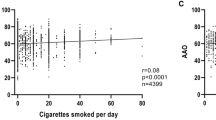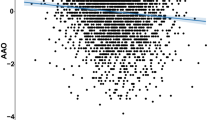Abstract
The objective of this study was to explore combined effects of four candidate susceptibility genes and two exposures on Parkinson’s disease (PD) risk; namely, α-synuclein (SNCA) promoter polymorphism REP1, microtubule-associated protein tau (MAPT) H1/H2 haplotypes, apolipoprotein E (APOE) ε2/ε3/ε4 polymorphism, ubiquitin carboxy-terminal esterase L1 (UCHL1) S18Y variant, cigarette smoking and caffeinated coffee consumption. 932 PD patients and 664 control subjects from the NeuroGenetics Research Consortium, with complete data on all six factors, were studied. Uniform protocols were used for diagnosis, recruitment, data collection and genotyping. A logistic regression model which included gene-exposure interactions was applied. Likelihood ratio tests (LRTs) were used for significance testing and Bayesian inference was used to estimate odds ratios (ORs). MAPT (P = 0.007), SNCA REP1 (P = 0.012), smoking (P = 0.001), and coffee (P = 0.011) were associated with PD risk. Two novel interactions were detected: APOE with coffee (P = 0.005), and REP1 with smoking (P = 0.021). While the individual main effects were modest, each yielding OR < 1.6, the effects were cumulative, with some combinations reaching OR = 12.6 (95% CI: 5.9–26.8). This study provides evidence for the long-held notion that PD risk is modulated by cumulative and interactive effects of genes and exposures. Furthermore, the study demonstrates that while interaction studies are useful for exploring risk relationships that might otherwise go undetected, results should be interpreted with caution because of the inherent loss of power due to multiple testing. The novel findings of this study that warrant replication are the evidence for interaction of coffee with APOE, and of smoking with REP1 on PD risk.
Similar content being viewed by others
References
Baker M, Litvan I, Houlden H, Adamson J, Dickson D, Perez-Tur J, Hardy J, Lynch T, Bigio E, Hutton M (1999) Association of an extended haplotype in the tau gene with progressive supranuclear palsy. Hum Mol Genet 8:711–715
Draper NR, Smith H (1998) Applied regression analysis, 3rd edn. Wiley, New York
Genkin A, Lewis D, Madigan D (2007) Large-scale Bayesian logistic regression for text categorization. technometrics (in press)
Gibb WR, Lees AJ (1988) The relevance of the Lewy body to the pathogenesis of idiopathic Parkinson’s disease. J. Neurol. Neurosurg. Psychiatry 51:745–752
Hardy J, Cai H, Cookson MR, Gwinn-Hardy K, Singleton A (2006) Genetics of Parkinson’s disease and parkinsonism. Ann Neurol 60:389–398
Harrell FE (2001) Regression modeling strategies: with applications to linear models, logistic regression and survival analysis. Springer, New York
Healy DG, Abou-Sleiman PM, Casas JP, Ahmadi KR, Lynch T, Gandhi S, Muqit MM, Foltynie T, Barker R, Bhatia KP, Quinn NP, Lees AJ, Gibson JM, Holton JL, Revesz T, Goldstein DB, Wood NW (2006) UCHL-1 is not a Parkinson’s disease susceptibility gene. Ann Neurol 59:627–633
Hernan MA, Takkouche B, Caamano-Isorna F, Gestal-Otero JJ (2002) A meta-analysis of coffee drinking, cigarette smoking, and the risk of Parkinson’s disease. Ann Neurol 52:276–284
Huang X, Chen PC, Poole C (2004) APOE-[epsilon]2 allele associated with higher prevalence of sporadic Parkinson disease. Neurology 62:2198–2202
Hutter CM, Samii A, Factor SA, Nutt JG, Higgins DS, Bird TD, Griffith A, Roberts JW, Leis BC, Montimurro JS, Kay DM, Edwards KL, Payami H, Zabetian CP (2007) Lack of evidence for an association between UCHL1 S18Y and Parkinson’s disease. Eur J Neurol [Epub ahead of print 18 Dec 2007]
Ioannidis JP, Trikalinos TA, Khoury MJ (2006) Implications of small effect sizes of individual genetic variants on the design and interpretation of genetic association studies of complex diseases. Am J Epidemiol 164:609–614
Kalda A, Yu L, Oztas E, Chen JF (2006) Novel neuroprotection by caffeine and adenosine A(2A) receptor antagonists in animal models of Parkinson’s disease. J Neurol Sci 248:9–15
Kay DM, Montimurro JS, Payami H (2008) Genetics. In: Factor SA, Weiner WJ (eds) Parkinson’s Disease: diagnosis and clinical management, 2nd edn. Demos Medical Publishing, New York
Kruger R, Vieira-Saecker AMM, Kuhn W, Berg D, Muller T, HKuhnl N, Fuchs GA, Storch A, Hungs M, Woitalla D, Przuntek H, Epplen JT, Schols L, Riess O (1999) Increased susceptibility to sporadic Parkinson’s disease by a certain combined alpha-synuclein/apolipoprotein E genotype. Ann Neurol 45:611–617
Lin DY, Psaty BM, Kronmal RA (1998) Assessing the sensitivity of regression results to unmeasured confounders in observational studies. Biometrics 54:948–963
Maraganore DM, Lesnick TG, Elbaz A, Chartier-Harlin MC, Gasser T, Kruger R, Hattori N, Mellick GD, Quattrone A, Satoh J, Toda T, Wang J, Ioannidis JP, de Andrade M, Rocca WA (2004) UCHL1 is a Parkinson’s disease susceptibility gene. Ann Neurol 55:512–521
Maraganore DM, de Andrade M, Elbaz A, Farrer MJ, Ioannidis JP, Kruger R, Rocca WA, Schneider NK, Lesnick TG, Lincoln SJ, Hulihan MM, Aasly JO, Ashizawa T, Chartier-Harlin MC, Checkoway H, Ferrarese C, Hadjigeorgiou G, Hattori N, Kawakami H, Lambert JC, Lynch T, Mellick GD, Papapetropoulos S, Parsian A, Quattrone A, Riess O, Tan EK, Van Broeckhoven C (2006) Collaborative analysis of alpha-synuclein gene promoter variability and Parkinson disease. J Am Med Assoc 296:661–670
Marchini J, Donnelly P, Cardon LR (2005) Genome-wide strategies for detecting multiple loci that influence complex diseases. Nat Genet 37:413–417
Mayeux R (2003) Epidemiology of neurodegeneration. Annu Rev Neurosci 26:81–104
Parain K, Hapdey C, Rousselet E, Marchand V, Dumery B, Hirsch EC (2003) Cigarette smoke and nicotine protect dopaminergic neurons against the 1-methyl-4-phenyl-1,2,3,6-tetrahydropyridine Parkinsonian toxin. Brain Res 984:224–232
Polymeropoulos M, Lavedan C, Leroy E, Ide S, Dehejia A, Dutra A, Pike B, Root H, Rubenstein J, Boyer R, Stenroos E, Chandrasekharappa S, Athanassiadou A, Papapetropoulos T, Johnson W, Lazzarini A, Duvoisin R, Di Iorio G, Golbe L, Nussbaum R (1997) Mutation in the alpha-synuclein gene identified in families with Parkinson’s disease. Science 276:2045–2047
Powers KM, Kay DM, Factor SA, Zabetian CP, Higgins DS, Samii A, Nutt JG, Griffith A, Leis B, Roberts JW, Martinez ED, Montimurro JS, Checkoway H, Payami H (2007) Combined effects of smoking, coffee, and NSAIDs on Parkinson’s disease risk. movement disorders [Epub ahead of print 6 Nov 2007]
Quik M, Di Monte DA (2001) Nicotine administration reduces striatal MPP+ levels in mice. Brain Res 917:219–224
Quik M, Parameswaran N, McCallum SE, Bordia T, Bao S, McCormack A, Kim A, Tyndale RF, Langston JW, Di Monte DA (2006) Chronic oral nicotine treatment protects against striatal degeneration in MPTP-treated primates. J Neurochem 98:1866–1875
Santner D, Duffy T (1989) The statistical analysis of discreet data. Springer, New York
Schwarzschild MA, Chen JF, Ascherio A (2002) Caffeinated clues and the promise of adenosine A(2A) antagonists in PD. Neurology 58:1154–1160
Sell SM, Ren K (1997) Automated capillary electrophoresis in the genotyping of apolipoprotein E. Genomics 46:163–164
Singleton AB, Farrer M, Johnson J, Singleton A, Hague S, Kachergus J, Hulihan M, Peuralinna T, Dutra A, Nussbaum R, Lincoln S, Crawley A, Hanson M, Maraganore D, Adler C, Cookson MR, Muenter M, Baptista M, Miller D, Blancato J, Hardy J, Gwinn-Hardy K (2003) alpha-Synuclein locus triplication causes Parkinson’s disease. Science 302:841
Thomas A, Hara B, Ligges l, Sturtz S (2006) Making BUGS open. R News 6:12–17
Topol EJ, Murray SS, Frazer KA (2007) The genomics gold rush. JAMA 298:218–221
Vance JE, Karten B, Hayashi H (2006) Lipid dynamics in neurons. Biochem Soc Trans 34:399–403
Zabetian CP, Hutter CM, Factor SA, Nutt JG, Higgins DS, Griffith A, Roberts JW, Leis BC, Kay DM, Yearout D, Montimurro JS, Edwards KL, Samii A, Payami H (2007) Association analysis of MAPT H1 haplotype and subhaplotypes in Parkinson’s disease. Ann Neurol 62:137–144
Zhang J, Song Y, Chen H, Fan D (2005) The tau gene haplotype h1 confers a susceptibility to Parkinson’s disease. Eur Neurol 53:15–21
Acknowledgments
We thank the research subjects for participation in this study. This study was supported by Michael J. Fox Foundation Edmond J. Safra Global Genetics Consortia Grant; National Institutes of Health grants NS R01-36960 and K08-NS044138; VA Merit Award; Parkinson’s Disease, Mental Health and Geriatric Research Education and Clinical Centers at the VA Puget Sound Health Care System, Close to A Cure: A Fund for Parkinson’s Research of the Foundation for the Carolinas, and New York State Department of Health Wadsworth Center. The content is solely the responsibility of the authors and does not necessarily represent the official views of the funding agencies.
Author information
Authors and Affiliations
Corresponding author
Electronic supplementary material
Below is the link to the electronic supplementary material.
Rights and permissions
About this article
Cite this article
McCulloch, C.C., Kay, D.M., Factor, S.A. et al. Exploring gene-environment interactions in Parkinson’s disease. Hum Genet 123, 257–265 (2008). https://doi.org/10.1007/s00439-008-0466-z
Received:
Accepted:
Published:
Issue Date:
DOI: https://doi.org/10.1007/s00439-008-0466-z




